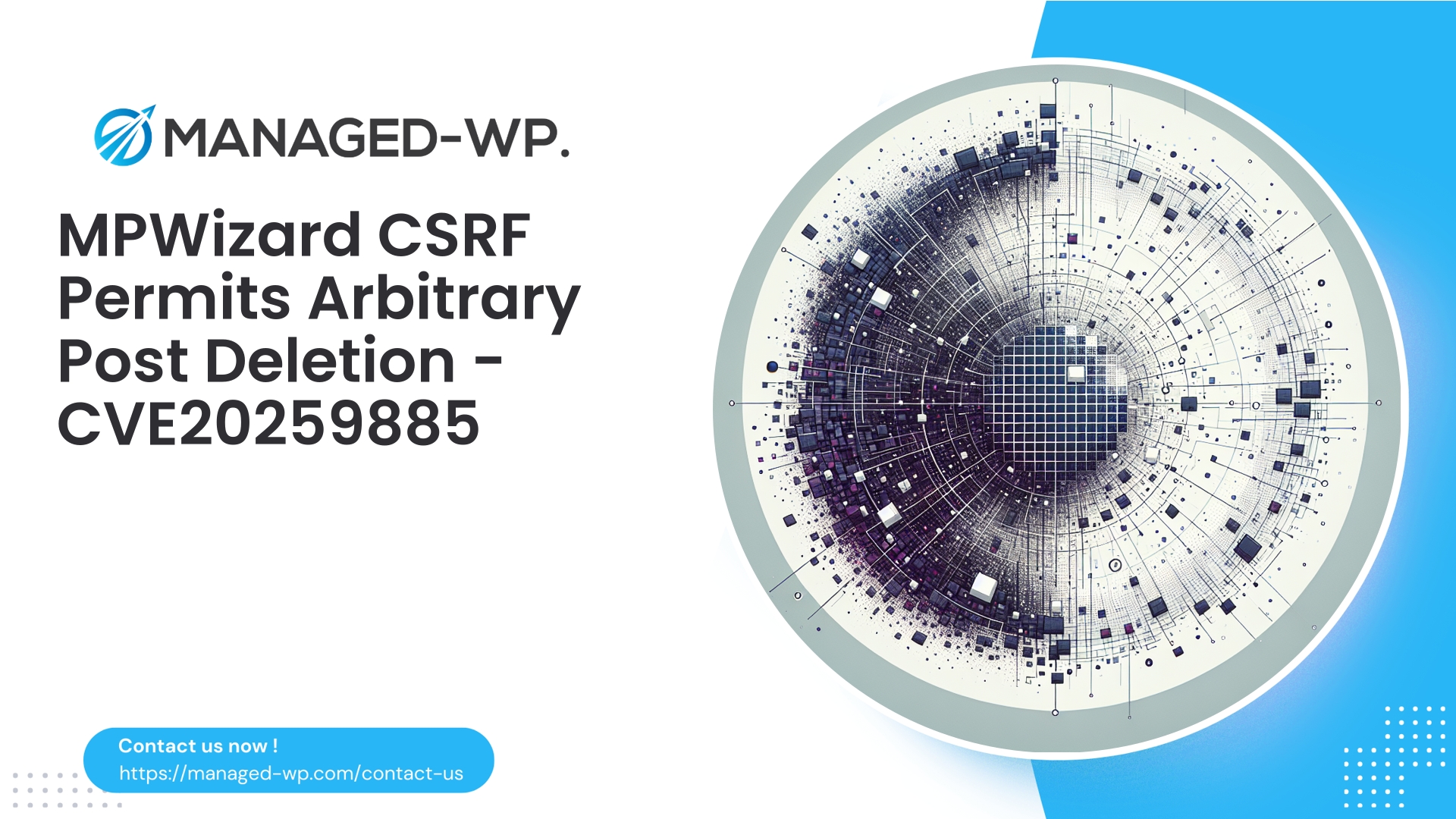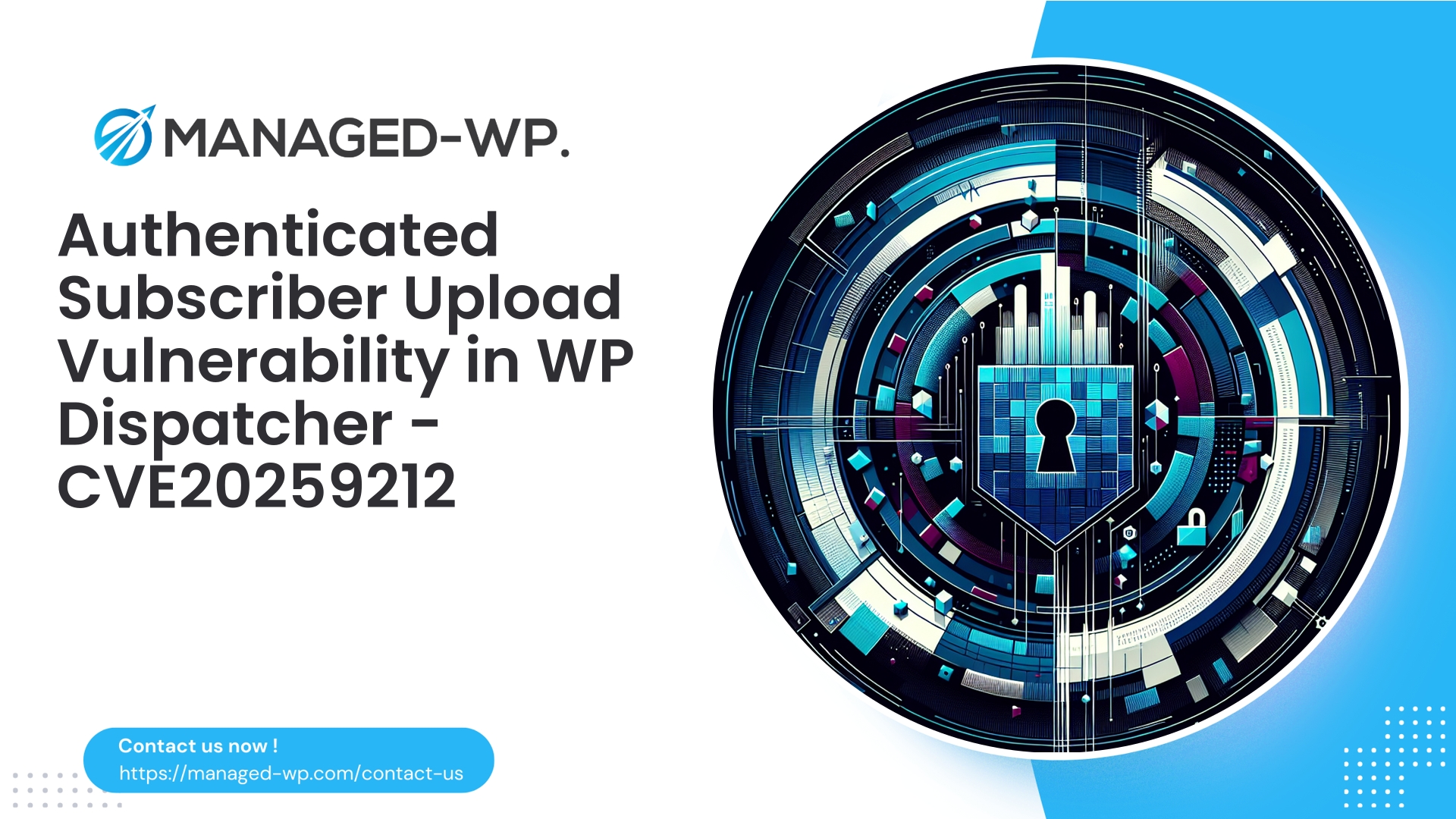| 插件名稱 | JoomSport |
|---|---|
| 漏洞類型 | 目錄遍歷 |
| CVE編號 | CVE-2025-7721 |
| 緊急 | 高的 |
| CVE 發布日期 | 2025-10-03 |
| 來源網址 | CVE-2025-7721 |
緊急安全公告:JoomSport ≤ 5.7.3 – 未經驗證的目錄遍歷導致本機檔案包含漏洞 (CVE-2025-7721)
日期: 2025年10月3日
嚴重程度: 高(CVSS 8.1)
受影響版本: JoomSport WordPress 外掛程式 ≤ 5.7.3
補丁可用: 版本 5.7.4
安全研究員: 麥克邁爾斯
身為 Managed-WP 的專業安全專家,我們致力於提供關於 WordPress 外掛程式新漏洞的精準、可操作的情報。新揭露的 CVE-2025-7721 漏洞影響 JoomSport 插件,該漏洞利用未經驗證的目錄遍歷漏洞,實現本機檔案包含 (LFI) 攻擊。此遠端漏洞允許攻擊者在無需任何身份驗證的情況下存取關鍵伺服器文件,例如: wp-config.php暴露敏感憑證和配置資料。
本公告概述了漏洞的性質、相關風險、技術層面的利用方法、偵測策略以及保護 WordPress 環境的優先建議。
網站所有者總結:要點速覽
- 漏洞: 在 JoomSport 版本 ≤ 5.7.3 中,未經驗證的目錄遍歷會導致本機檔案包含攻擊 (LFI)。
- 風險影響: 精心建構的請求可能會洩漏敏感檔案(資料庫憑證、API 金鑰、伺服器配置),導致整個網站可能被攻破。
- 嚴重程度評分: CVSS v3.1 8.1(高)
- 補救措施: 立即升級至 JoomSport 5.7.4 或更高版本。
- 臨時緩解措施: 應用 Web 應用程式防火牆 (WAF) 規則來阻止穿越有效載荷、限制對敏感文件的存取以及實施伺服器加固(例如,
open_basedir停用allow_url_include). - 攻擊跡象: 監控包含可疑請求的訊息
../針對插件端點、異常用戶代理程式和回應日誌中意外敏感資料的序列或編碼變體。 - 應對優先事項: 1)更新外掛程式;2)部署虛擬修補程式/WAF規則;3)加強基礎設施;4)如果懷疑系統遭到入侵,則執行事件回應協定。
什麼是 JoomSport?為什麼這個漏洞需要您關注?
JoomSport是一款廣泛用於WordPress網站的運動聯盟、賽果和賽程管理外掛。雖然它服務於特定的用戶群體,但每個活躍的插件都會不可避免地擴大網站的攻擊面。
這次攻擊的核心問題是未經身份驗證的目錄遍歷漏洞,攻擊者可以利用該漏洞包含任意本地檔案。要點包括:
- 無需用戶憑證——任何遠端攻擊者都可能利用此漏洞。
- 該漏洞允許攻擊者存取預期目錄之外的路徑,並暴露敏感檔案。
- 關鍵伺服器資料可能洩露,包括洩露資料庫憑證的設定檔。
- 考慮到遠端攻擊途徑,主動掃描和攻擊活動極有可能發生。
經營 JoomSport 5.7.3 或更早版本的網站必須將此視為嚴重且迫在眉睫的威脅。
技術解析:目錄遍歷到本機檔案包含 (LFI)
此漏洞源自於插件未能正確清理使用者提供的檔案路徑輸入。攻擊者可以利用遍歷令牌,例如: ../ 或其 URL 編碼形式(%2e%2e%2f)超出預期的目錄範圍。
當外掛程式隨後基於這些被篡改的輸入包含或讀取檔案時,它可以將任意本地文件內容傳回給攻擊者。關鍵技術屬性如下:
- 攻擊向量: 向接受檔案路徑參數的外掛端點傳送 HTTP 請求。
- 有效載荷: 目錄遍歷序列(普通、雙重編碼或以 NULL 位元組結尾)。
- 影響: 揭露任何可透過 Web 伺服器程序存取的可讀檔案(例如,
wp-config.php(日誌、系統檔)。 - 驗證: 無需任何要求。
- 廠商修復: 5.7.4 版本引入了輸入驗證和清理功能,以消除遍歷攻擊。
由於漏洞暴露了敏感文件,因此可以直接導致資料庫憑證被盜、透過鍊式攻擊執行遠端程式碼以及整個網站被攻破。
為什麼本地文件包含對 WordPress 來說尤其危險
在 WordPress 環境中引入本機檔案可能會導致一系列安全漏洞,並造成嚴重後果:
- 資料庫憑證被盜:
wp-config.php儲存資料庫名稱、使用者、密碼和主機-以便在資料庫遭到入侵時能夠直接存取資料庫。 - API 和身份驗證金鑰洩漏: 其他設定檔可能會洩漏 API 金鑰、SMTP 憑證或驗證令牌。
- 資訊外洩: 存取日誌和備份可以洩露使用者身分和網站結構。
- 權限提升和程式碼執行: 將本機檔案包含漏洞與其他漏洞結合起來,攻擊者可以遠端注入可執行程式碼。
- 監理與隱私風險: 個人資料外洩可能引發違規行為(GDPR、CCPA),並削弱用戶信任。
這是一個不容忽視的漏洞。
哪些人會受到影響?
- 任何安裝了 JoomSport 外掛程式 5.7.3 或更早版本的 WordPress 網站。
- 具有面向公眾的插件端點且不受 IP 限制的網站。
- 缺乏強化型 PHP 或 Web 伺服器配置的環境。
- 缺乏全面備份和監控策略的網站。
立即透過 WordPress 控制面板或文件檢查來驗證您的外掛程式版本,以評估風險。
分步緊急補救計劃
請依照以下順序優先採取這些行動,以求最快見效:
-
插件更新至 5.7.4 或更高版本
- 原因:官方廠商補丁移除了不安全的包含項並驗證了輸入。
- 方法:使用 WordPress 管理背景或 WP-CLI 指令,例如:
wp插件更新joomsport
- 注意:如果對插件的依賴程度較高,需要進行測試,請盡快更新。
-
透過 WAF 規則實施虛擬修補(如果無法立即更新)
- 阻止已知的遍歷有效載荷(例如,
../,%2e%2e%2f,以及 NULL 位元組)針對 JoomSport 端點。 - 阻止對高風險文件的請求,例如
wp-config.php,.env以及系統檔案。 - 對來自相同 IP 位址的重複可疑請求進行速率限制。
WAF概念邏輯範例:
- 阻止包含遍歷序列參數的 GET/POST 請求。
- 如果回應中洩漏了資料庫金鑰或敏感字串給未經身份驗證的請求,則觸發警報。
- 阻止已知的遍歷有效載荷(例如,
-
限制伺服器對敏感文件的訪問
- 使用
.htaccess或使用 Nginx 規則拒絕網站訪問wp-config.php以及其他類似的關鍵文件。 - 停用目錄清單和不必要的腳本執行。
- 使用
-
強化 PHP 配置
- 停用
allow_url_include = 關閉 - 放
open_basedir網站目錄的限制 - 停用
expose_php
- 停用
-
主動掃描日誌和文件,尋找入侵指標
- 搜尋存取日誌,尋找目錄遍歷和編碼有效載荷模式。
- 檢查是否有可疑的文件修改或新的管理員使用者。
-
如果出現入侵跡象,立即啟動事件回應程式。
- 隔離網站(維護模式或 IP 限制)。
- 確保取證備份的安全,並識別被利用的文件和時間軸。
- 清除資料或恢復到受損前的備份。
- 輪換所有憑證和 API 金鑰。
偵測:識別攻擊企圖
監控對於發現正在進行的攻擊或攻擊後的活動至關重要。請注意以下方面:
- 包含編碼或原始目錄遍歷字串的請求(
../,%2e%2e%2f(雙重編碼變體)。 - 指向 JoomSport 外掛程式路徑的 URL 中存在異常參數,這些路徑引用了檔案。
- 未經身份驗證的使用者收到的 HTTP 回應中的資料庫相關關鍵字 (
資料庫名稱,資料庫密碼). - JoomSport端點收到大量失敗或可疑請求。
- 管理員帳戶發生意外更改,或在可疑時間戳記附近執行計劃任務。
- 來自 Web 伺服器的未經授權的出站連線。
在日誌管理或 SIEM 平台中啟用警報,並啟動 Managed-WP 的 WAF 規則,以應對目錄遍歷和 LFI 攻擊模式。
建議的 WAF/虛擬補丁規則
當立即修補不切實際時,虛擬修補提供了至關重要的防禦措施:
- 阻止查詢/post 參數中的所有遍歷有效負載(
\.\./,%2e%2e%2f(空字節)。 - 阻止嘗試存取受保護文件的請求(
wp-config.php,.env(系統設定檔)。 - 包含絕對檔案路徑的區塊參數(例如,以…開頭)
/或 Windows 磁碟機代號)。 - 對出現重複攻擊模式的IP位址進行限流或屏蔽。
- 質疑或阻止可疑用戶代理(通常是自動掃描器的用戶代理)。
- (可選)檢查響應內容是否有洩漏指標,並據此進行阻止。
偽規則範例:
觸發器:對包含路徑的 HTTP 請求 /joomsport/ AND parameter matches traversal pattern:
(?:\.\./|%2e%2e%2f|%252e%252e%252f|%2e%2e%5c|%5c\.\.|%2e%2e%2f)
Action: Block + Log + Notify Administrator
測試說明: 首先啟用監控模式,以減少誤報。
伺服器加強:超越即時緩解措施
- 授予最小寫入權限;避免
777. - 將 WordPress 資料庫使用者權限限制在必要的最低限度。
- 如果不需要,請停用危險的 PHP 函數
執行長,shell_exec, ETC。 - 使用
open_basedir限制 PHP 操作只能在必要的目錄中進行。 - 強制使用 HTTPS 並啟用 HTTP 嚴格傳輸安全性 (HSTS)。
- 定期進行異地版本化備份。
- 實施文件完整性監控工具,以追蹤未經授權的文件變更。
- 盡量減少外掛和主題的使用;移除不常用的元件。
事件回應檢查表
- 立即隔離受影響區域。
- 建立日誌、檔案和資料庫的完整備份,以便進行取證分析。
- 識別檔案系統和資料庫中的未經授權的變更或後門。
- 移除所有惡意程式和未經授權的使用者帳戶。
- 輪換所有機密資訊:資料庫密碼、API 金鑰、鹽值、FTP 憑證。
- 從入侵發生前建立的乾淨備份中復原。
- 實施改進的監控和網路應用程式防火牆規則。
- 根據資料保護法律的要求通知受影響方。
如果公司內部專業技術有限,請聘請具有 WordPress 安全專業知識的專業事件回應服務提供者。
常見問題解答
問: “如果我已更新到 5.7.4 版本,我的系統安全嗎?”
一個: 是的,此次更新已修復該漏洞。但是,請檢查日誌以確認先前未發生任何利用漏洞的情況。
問: “如果我不能立即更新怎麼辦?”
一個: 使用虛擬補丁並限制對插件端點的存取。盡快安排升級。
問: 「正在阻止 ../ 足夠的? 」
一個: 沒有哪一種單一的緩解措施是萬無一失的。結合WAF防護、伺服器加固和補丁更新至關重要。
問: “我應該卸載這個插件嗎?”
一個: 如果未使用,則需要隔離。否則,請隔離並保護該插件,直到修復為止。
Managed-WP 如何增強您的安全態勢
Managed-WP 提供全面的 WordPress 安全平台,旨在透過以下方式縮小攻擊面並快速應對新威脅:
- 針對 WordPress 及其插件,由專家精心管理的防火牆和 WAF 規則。
- 虛擬修補技術可立即阻止新揭露的漏洞。
- 自動惡意軟體掃描,偵測可疑檔案和行為。
- 持續監控並發出異常活動和文件變更警報。
- 主動式加固指導和自動強制執行安全伺服器配置。
- 清晰的事件回應工作流程,並可獲得專家協助。
如果外掛程式更新延遲,Managed-WP 的分層防禦機制可以防止漏洞嘗試並提醒您注意可疑事件,從而爭取關鍵時間。
建議行動時間表
- 數小時內: 確認插件版本並更新至 5.7.4。如果無法更新,請部署 WAF 規則。
- 24小時內: 審核日誌,加強伺服器和 PHP 設置,確保有可靠的備份。
- 72小時內: 進行全面的安全掃描並檢查憑證安全性。
- 兩週內: 清理外掛程式清單,檢視使用者角色,必要時安排安全評估。
管理員日誌查詢範例
- Apache 日誌:
grep -E '(\.\./|%2e%2e%2f|%252e%252e%252f|%2e%2e%5c|%5c\.\.)' /var/log/apache2/access.log
- Nginx 日誌:
zgrep -E '(\.\./|%2e%2e%2f|%2e%2e%5c|%252e%252e%252f)' /var/log/nginx/access.log*
- 搜尋文件以查找資料庫密碼外洩:
grep -R "DB_PASSWORD" /var/www/html
請負責任地使用這些查詢,如果偵測到可疑活動,請保留日誌。
管理多個站點的代理商和主機商的最佳實踐
- 維護客戶站點上詳細的插件/版本清單。
- 根據 CVSS 評分和網站敏感性(支付處理商、PII 處理)優先修復補丁。
- 在可行的情況下,透過安排維護視窗實現自動更新。
- 利用集中式 Managed-WP WAF 策略實現大規模快速緩解。
- 定期測試和驗證備份和復原流程。
結語:立即採取行動至關重要
CVE-2025-7721 中詳細描述的 JoomSport RCE 前 LFI 漏洞是一個高風險漏洞,攻擊者會積極利用該漏洞,並且可以透過自動化方式在網路上進行攻擊。
請立即更新您的 JoomSport 外掛程式。如果無法更新,請使用 Managed-WP 的虛擬修補程式和分層安全控制來降低風險,同時進行修復和加強工作。
請記住:強大的安全態勢並非單一維度,而是結合了修補程式、監控、伺服器加固和快速事件回應。
立即使用 Managed-WP 保護您的 WordPress 網站
立即開始使用 Managed-WP 的免費基礎安全計劃
為了在您更新和保護網站的同時提供即時的防禦保障,Managed-WP 的基礎套餐提供以下基本保護:
- 託管防火牆和 WordPress 優化型 Web 應用程式防火牆 (WAF)
- 無限頻寬,安全處理您的網路流量
- 惡意軟體和可疑文件掃描
- 針對 OWASP Top 10 漏洞和常見 WordPress 漏洞的緩解措施
免費註冊: https://my.managed-wp.com/buy/managed-wp-basic-plan/
如需增強功能(自動惡意軟體清除、精細的 IP 控制、每月安全報告和大規模虛擬修補程式),請考慮 Managed-WP 標準版或專業版。
如果您需要協助評估事件、驗證漏洞利用狀態或應用程式託管虛擬補丁,請立即透過您的控制面板或託管提供者聯絡 Managed-WP 支持,以保護您的易受攻擊環境。



















